Electrodes Based on Carbon Aerogels Partially Graphitized by Doping with Transition Metals for Oxygen Reduction Reaction
Abstract
:1. Introduction
2. Materials and Methods
2.1. Preparation and Characterization of the Materials
2.2. Electro-Chemical Studies. Oxygen Reduction Reaction
3. Results
4. Discussion
5. Conclusions
Acknowledgments
Author Contributions
Conflicts of Interest
References
- Jung, D.H.; Bae, S.J.; Kim, S.J.; Nahm, K.S.; Kim, P. Effect of the Pt precursor on the morphology and catalytic performance of Pt-impregnated on Pd/C for the oxygen reduction reaction in polymer electrolyte fuel cells. Int. J. Hydrog. Energy 2011, 36, 9115–9122. [Google Scholar] [CrossRef]
- Yang, Z.; Nie, H.; Chen, X.; Chen, X.; Huang, S. Recent progress in doped carbon nanomaterials as effective cathode catalysts for fuel cell oxygen reduction reaction. J. Power Sources 2013, 236, 238–249. [Google Scholar] [CrossRef]
- Banham, D.; Ye, S.; Pei, K.; Ozaki, J.-I.; Kishimoto, T.; Imashiro, Y. A review of the stability and durability of non-precious metal catalysts for the oxygen reduction reaction in proton exchange membrane fuel cells. J. Power Sources 2015, 285, 334–348. [Google Scholar] [CrossRef]
- Lee, C.L.; Chiou, H.P.; Syu, C.M.; Wu, C.C. Silver triangular nanoplates as electrocatalyst for oxygen reduction reaction. Electrochem. Commun. 2010, 12, 1609–1613. [Google Scholar] [CrossRef]
- Bo, X.; Zhang, Y.; Li, M.; Nsabimana, A.; Guo, L. NiCo2O4 spinel/ordered mesoporous carbons as noble-metal free electrocatalysts for oxygen reduction reaction and the influence of structure of catalyst support on the electrochemical activity of NiCo2O4. J. Power Sources 2015, 288, 1–8. [Google Scholar] [CrossRef]
- Stojmenović, M.; Momčilović, M.; Gavrilov, N.; Pašti, I.A.; Mentus, S.; Jokić, B.; Babić, B. Incorporation of Pt, Ru and Pt-Ru nanoparticles into ordered mesoporous carbons for efficient oxygen reduction reaction in alkaline media. Electrochim. Acta 2015, 153, 130–139. [Google Scholar] [CrossRef]
- Zhao, A.; Masa, J.; Xia, W. Oxygen-deficient titania as alternative support for Pt catalysts for the oxygen reduction reaction. J. Energy Chem. 2014, 23, 701–707. [Google Scholar] [CrossRef]
- Kim, J.H.; Chang, S.; Kim, Y.T. Compressive strain as the main origin of enhanced oxygen reduction reaction activity for Pt electrocatalysts on chromium-doped titania support. Appl. Catal. B Environ. 2014, 158–159, 112–118. [Google Scholar] [CrossRef]
- Ahmed, M.S.; Kim, D.; Jeon, S. Covalently grafted platinum nanoparticles to multi walled carbon nanotubes for enhanced electrocatalytic oxygen reduction. Electrochim. Acta 2013, 92, 168–175. [Google Scholar] [CrossRef]
- Oh, J.-M.; Park, J.; Kumbhar, A.; Smith, D.; Creager, S. Electrochemical Oxygen Reduction at Platinum/Mesoporous Carbon/Zirconia/Ionomer Thin-Film Composite Electrodes. Electrochim. Acta 2014, 138, 278–287. [Google Scholar] [CrossRef]
- Dou, S.; Shen, A.; Ma, Z.; Wu, J.; Tao, L.; Wang, S. N-, P- and S-tridoped graphene as metal-free electrocatalyst for oxygen reduction reaction. J. Electroanal. Chem. 2015, 753, 21–27. [Google Scholar] [CrossRef]
- Ishii, T.; Maie, T.; Kimura, N.; Kobori, Y.; Imashiro, Y.; Ozaki, J.-I. Enhanced catalytic activity of nanoshell carbon co-doped with boron and nitrogen in the oxygen reduction reaction. Int. J. Hydrog. Energy 2017, 42, 5–12. [Google Scholar] [CrossRef]
- Sarapuu, A.; Kreek, K.; Kisand, K.; Kook, M.; Uibu, M.; Koel, M.; Tammeveski, K. Electrocatalysis of oxygen reduction by iron-containing nitrogen-doped carbon aerogels in alkaline solution. Electrochim. Acta 2017, 230, 81–88. [Google Scholar] [CrossRef]
- Elmouwahidi, A.; Vivo-Vilches, J.F.; Pérez-Cadenas, A.F.; Maldonado-Hódar, F.J.; Carrasco-Marín, F. Free metal oxygen-reduction electro-catalysts obtained from biomass residue of the olive oil industry. Chem. Eng. J. 2016, 306, 1109–1115. [Google Scholar] [CrossRef]
- Pekala, R.W.; Alviso, C.T.; Kong, F.M.; Hulsey, S.S. Aerogels derived from multifunctional organic monomers. J. Non-Cryst. Solids 1992, 145, 90–98. [Google Scholar] [CrossRef]
- ElKhatat, A.M.; Al-Muhtaseb, S.A. Advances in tailoring resorcinol-formaldehyde organic and carbon gels. Adv. Mater. 2011, 23, 2887–2903. [Google Scholar] [CrossRef] [PubMed]
- Gallegos-Suárez, E.; Pérez-Cadenas, A.F.; Maldonado-Hódar, F.J.; Carrasco-Marín, F. On the micro-and mesoporosity of carbon aerogels and xerogels. The role of the drying conditions during the synthesis processes. Chem. Eng. J. 2012, 181, 851–855. [Google Scholar] [CrossRef]
- Morales-Torres, S.; Maldonado-Hódar, F.J.; Pérez-Cadenas, A.F.; Carrasco-Marín, F. Textural and mechanical characteristics of carbon aerogels synthesized by polymerization of resorcinol and formaldehyde using alkali carbonates as basification agents. Phys. Chem. Chem. Phys. 2010, 12, 10365–10372. [Google Scholar] [CrossRef] [PubMed]
- Maldonado-Hódar, F.J.; Jirglová, H.; Pérez-Cadenas, A.F.; Morales-Torres, S. Chemical control of the characteristics of Mo-doped carbon xerogels by surfactant-mediated synthesis. Carbon N. Y. 2013, 51, 213–223. [Google Scholar] [CrossRef]
- Vivo-Vilches, J.F.; Carrasco-Marín, F.; Pérez-Cadenas, A.F.; Maldonado-Hódar, F.J. Fitting the porosity of carbon xerogel by CO2 activation to improve the TMP/n-octane separation. Microporous Mesoporous Mater. 2015, 209, 10–17. [Google Scholar] [CrossRef]
- Maldonado-Hódar, F.J.; Moreno-Castilla, C.; Carrasco-Marín, F.; Pérez-Cadenas, A.F. Reversible toluene adsorption on monolithic carbon aerogels. J. Hazard. Mater. 2007, 148, 548–552. [Google Scholar] [CrossRef] [PubMed]
- Bailon-Garcia, E.; Carrasco-Marin, F.; Perez-Cadenas, A.F.; Maldonado-Hodar, F.J. Microspheres of carbon xerogel: An alternative Pt-support for the selective hydrogenation of citral. Appl. Catal. A Gen. 2014, 482, 318–326. [Google Scholar] [CrossRef]
- Bailón-García, E.; Elmouwahidi, A.; Álvarez, M.A.; Carrasco-Marín, F.; Pérez-Cadenas, A.F.; Maldonado-Hódar, F.J. New carbon xerogel-TiO2 composites with high performance as visible-light photocatalysts for dye mineralization. Appl. Catal. B Environ. 2017, 201, 29–40. [Google Scholar] [CrossRef]
- Duarte, F.; Maldonado-Hódar, F.J.; Pérez-Cadenas, A.F.; Madeira, L.M. Fenton-like degradation of azo-dye Orange II catalyzed by transition metals on carbon aerogels. Appl. Catal. B Environ. 2009, 85, 139–147. [Google Scholar] [CrossRef]
- Maldonado-Hódar, F.J.; Moreno-Castilla, C.; Pérez-Cadenas, A.F. Catalytic combustion of toluene on platinum-containing monolithic carbon aerogels. Appl. Catal. B Environ. 2004, 54, 217–224. [Google Scholar] [CrossRef]
- Elmouwahidi, A.; Bailón-García, E.; Pérez-Cadenas, A.F.; Maldonado-Hódar, F.J.; Castelo-Quibén, J.; Carrasco-Marín, F. Electrochemical performances of supercapacitors from carbon-ZrO2 composites. Electrochim. Acta 2018, 259, 803–814. [Google Scholar] [CrossRef]
- Elmouwahidi, A.; Bailón-García, E.; Castelo-Quibén, J.; Pérez-Cadenas, A.F.; Maldonado-Hódar, F.J.; Carrasco-Marín, F. Carbon-TiO2 composites as high-performance supercapacitor electrodes: Synergistic effect between carbon and metal oxide phases. J. Mater. Chem. A 2018, 6. [Google Scholar] [CrossRef]
- Pérez-Cadenas, A.F.; Maldonado-Hódar, F.J.; Moreno-Castilla, C. Molybdenum carbide formation in molybdenum-doped organic and carbon aerogels. Langmuir 2005, 21, 10850–10855. [Google Scholar] [CrossRef] [PubMed]
- Maldonado-Hódar, F.J.; Pérez-Cadenas, A.F.; Moreno-Castilla, C. Morphology of heat-treated tunsgten doped monolithic carbon aerogels. Carbon N. Y. 2003, 41, 1291–1299. [Google Scholar] [CrossRef]
- Barrett, E.P.; Joyner, L.G.; Halenda, P.P. The determination of pore volume and area distributions in porous substances. I. Computations from nitrogen isotherms. J. Am. Chem. Soc. 1951, 73, 373–380. [Google Scholar] [CrossRef]
- Maldonado-Hódar, F.J.; Moreno-Castilla, C.; Pérez-Cadenas, A.F. Surface morphology, metal dispersion, and pore texture of transition metal-doped monolithic carbon aerogels and steam-activated derivatives. Microporous Mesoporous Mater. 2004, 69, 119–125. [Google Scholar] [CrossRef]
- Maldonado-Hódar, F.J.; Moreno-Castilla, C.; Rivera-Utrilla, J.; Hanzawa, Y.; Yamada, Y. Catalytic Graphitization of Carbon Aerogels by Transition Metals. Langmuir 2000, 16, 4367–4373. [Google Scholar] [CrossRef]
- NIST X-ray Photoelectron Spectroscopy Database. Available online: https://srdata.nist.gov/xps/ (accessed on 16 April 2018).
- Schwan, J.; Ulrich, S.; Batori, V.; Ehrhardt, H.; Silva, S.R.P. Raman spectroscopy on amorphous carbon films. J. Appl. Phys. 1996, 80, 440. [Google Scholar] [CrossRef] [Green Version]
- Wang, S.; Xu, Y.; Yan, M.; Zhai, Z.; Ren, B.; Zhang, L.; Liu, Z. Comparative study of metal-doped carbon aerogel: Physical properties and electrochemical performance. J. Electroanal. Chem. 2018, 809, 111–116. [Google Scholar] [CrossRef]
- Sarapuu, A.; Samolberg, L.; Kreek, K.; Koel, M.; Matisen, L.; Tammeveski, K. Cobalt- and iron-containing nitrogen-doped carbon aerogels as non-precious metal catalysts for electrochemical reduction of oxygen. J. Electroanal. Chem. 2015, 746, 9–17. [Google Scholar] [CrossRef]
- Chen, Z.; Higgins, D.; Yu, A.; Zhang, L.; Zhang, J. A review on non-precious metal electrocatalysts for PEM fuel cells. Energy Environ. Sci. 2011, 4, 3167–3192. [Google Scholar] [CrossRef]
- Shin, D.; An, X.; Choun, M.; Lee, J. Effect of transition metal induced pore structure on oxygen reduction reaction of electrospun fibrous carbon. Catal. Today 2016, 260, 82–88. [Google Scholar] [CrossRef]
- Chao, S.; Zhang, Y.; Wang, K.; Bai, Z.; Yang, L. Flower—like Ni and N codoped hierarchical porous carbon microspheres with enhanced performance for fuel cell storage. Appl. Energy 2016, 175, 421–428. [Google Scholar] [CrossRef]
- Quílez-Bermejo, J.; González-Gaitán, C.; Morallón, E.; Cazorla-Amorós, D. Effect of carbonization conditions of polyaniline on its catalytic activity towards ORR. Some insights about the nature of the active sites. Carbon N. Y. 2017, 119, 62–71. [Google Scholar] [CrossRef]
- Ferrero, G.A.; Preuss, K.; Fuertes, A.B.; Sevilla, M.; Titirici, M.-M. The influence of pore size distribution on the oxygen reduction reaction performance in nitrogen doped carbon microspheres. J. Mater. Chem. A 2016, 4, 2581–2589. [Google Scholar] [CrossRef]
- Zhao, X.; Zhao, H.; Zhang, T.; Yan, X.; Yuan, Y.; Zhang, H.; Zhao, H.; Zhang, D.; Zhu, G.; Yao, X. One-step synthesis of nitrogen-doped microporous carbon materials as metal-free electrocatalysts for oxygen reduction reaction. J. Mater. Chem. A 2014, 2, 11666–11671. [Google Scholar] [CrossRef]
- Pan, F.; Cao, Z.; Zhao, Q.; Liang, H.; Zhang, J. Nitrogen-doped porous carbon nanosheets made from biomass as highly active electrocatalyst for oxygen reduction reaction. J. Power Sources 2014, 272, 8–15. [Google Scholar] [CrossRef]
- Fu, X.; Liu, Y.; Cao, X.; Jin, J.; Liu, Q.; Zhang, J. FeCo–Nx embedded graphene as high performance catalysts for oxygen reduction reaction. Appl. Catal. B Environ. 2013, 130–131, 143–151. [Google Scholar] [CrossRef]
- González-Gaitán, C.; Ruiz-Rosas, R.; Morallón, E.; Cazorla-Amorós, D. Relevance of the Interaction between the M-Phthalocyanines and Carbon Nanotubes in the Electroactivity toward ORR. Langmuir 2017, 33, 11945–11955. [Google Scholar] [CrossRef] [PubMed]
- Liu, X.; Yu, Y.; Niu, Y.; Bao, S.; Hu, W. Cobalt nanoparticle decorated graphene aerogel for efficient oxygen reduction reaction electrocatalysis. Int. J. Hydrog. Energy 2017, 42, 5930–5937. [Google Scholar] [CrossRef]
- Wang, M.-Q.; Ye, C.; Wang, M.; Li, T.-H.; Yu, Y.-N.; Bao, S.-J. Synthesis of M (Fe3C, Co, Ni)-porous carbon frameworks as high-efficient ORR catalysts. Energy Storage Mater. 2018, 11, 112–117. [Google Scholar] [CrossRef]
- Goubert-Renaudin, S.N.S.; Wieckowski, A. Ni and/or Co nanoparticles as catalysts for oxygen reduction reaction (ORR) at room temperature. J. Electroanal. Chem. 2011, 652, 44–51. [Google Scholar] [CrossRef]
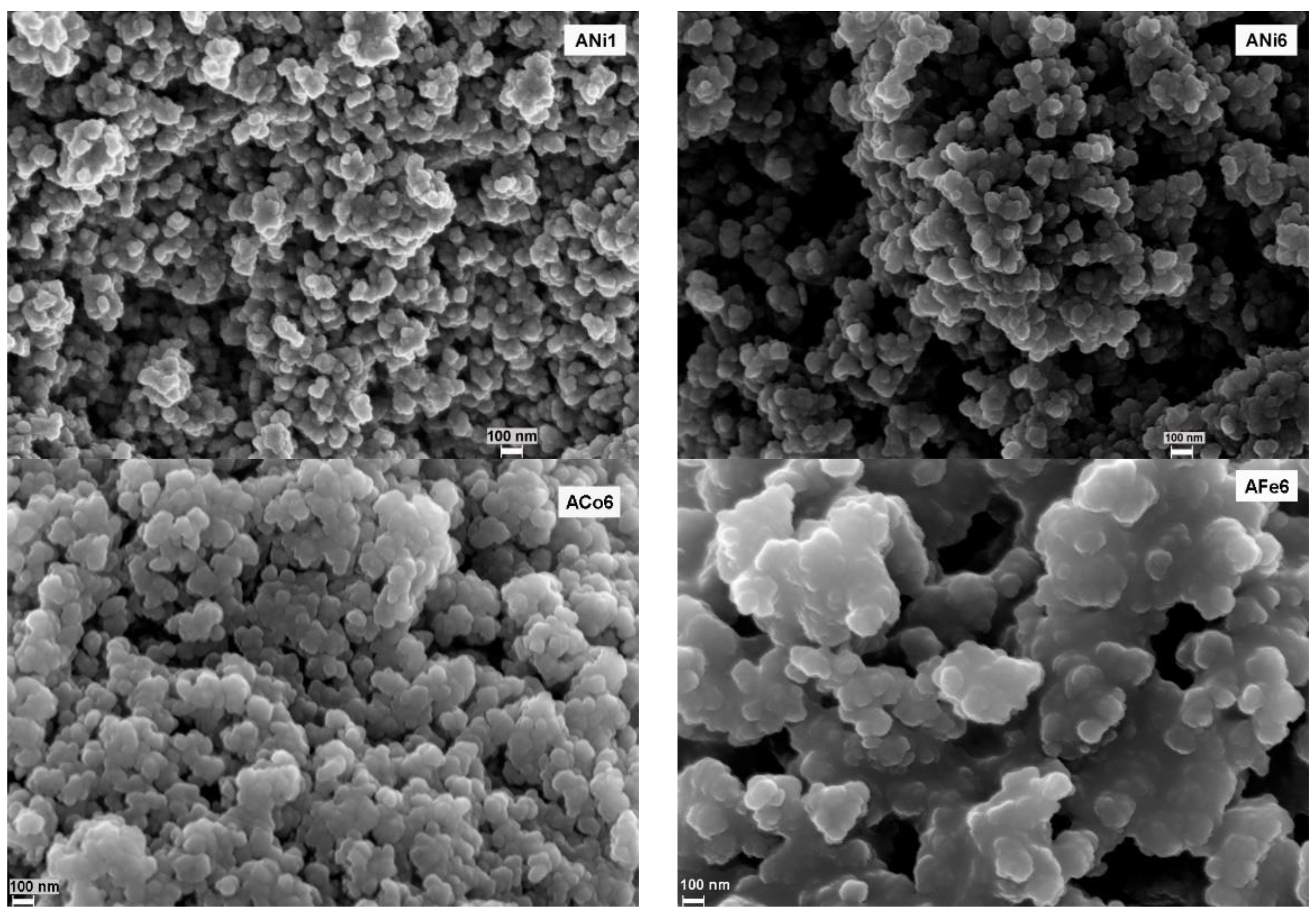
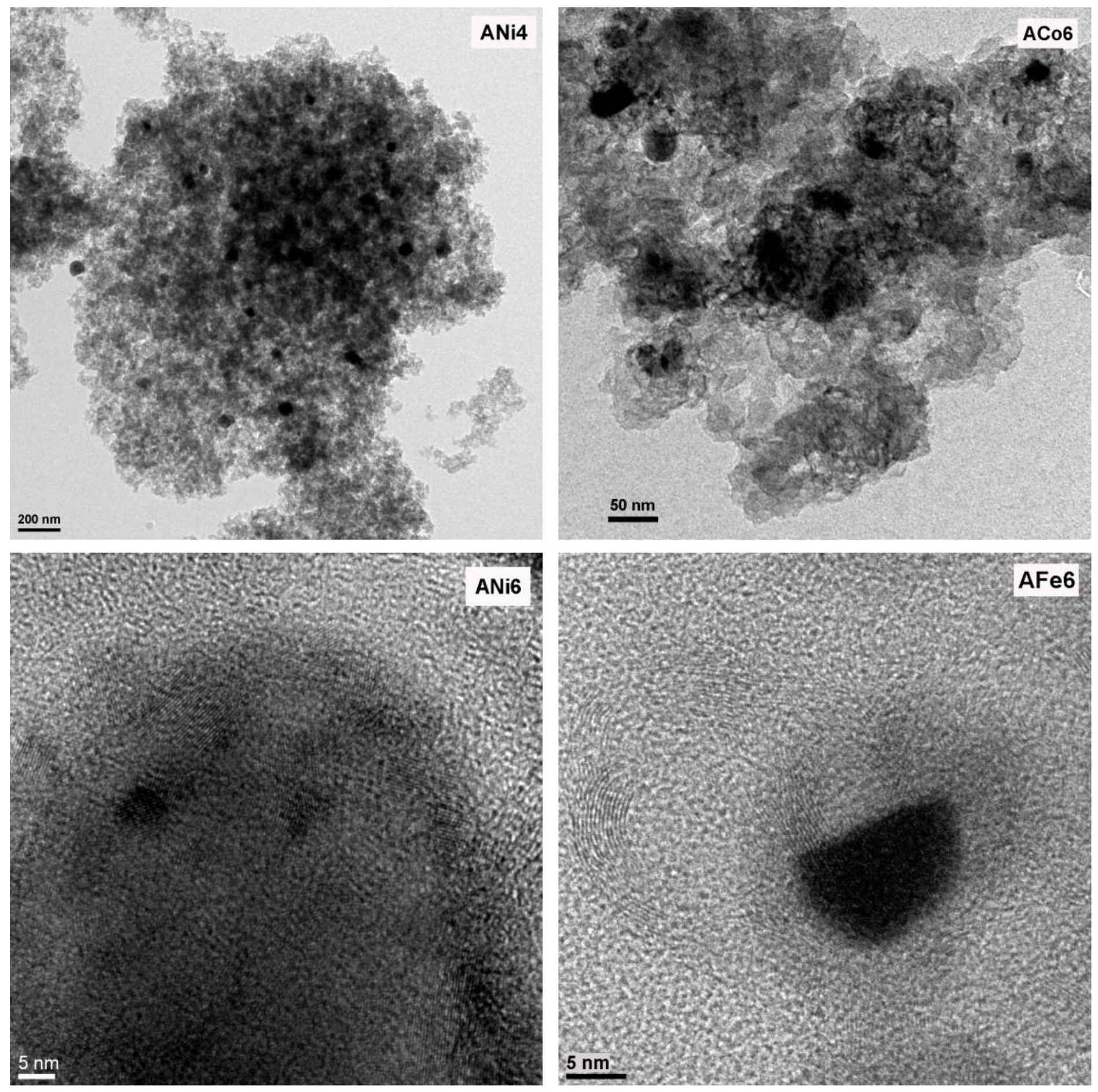
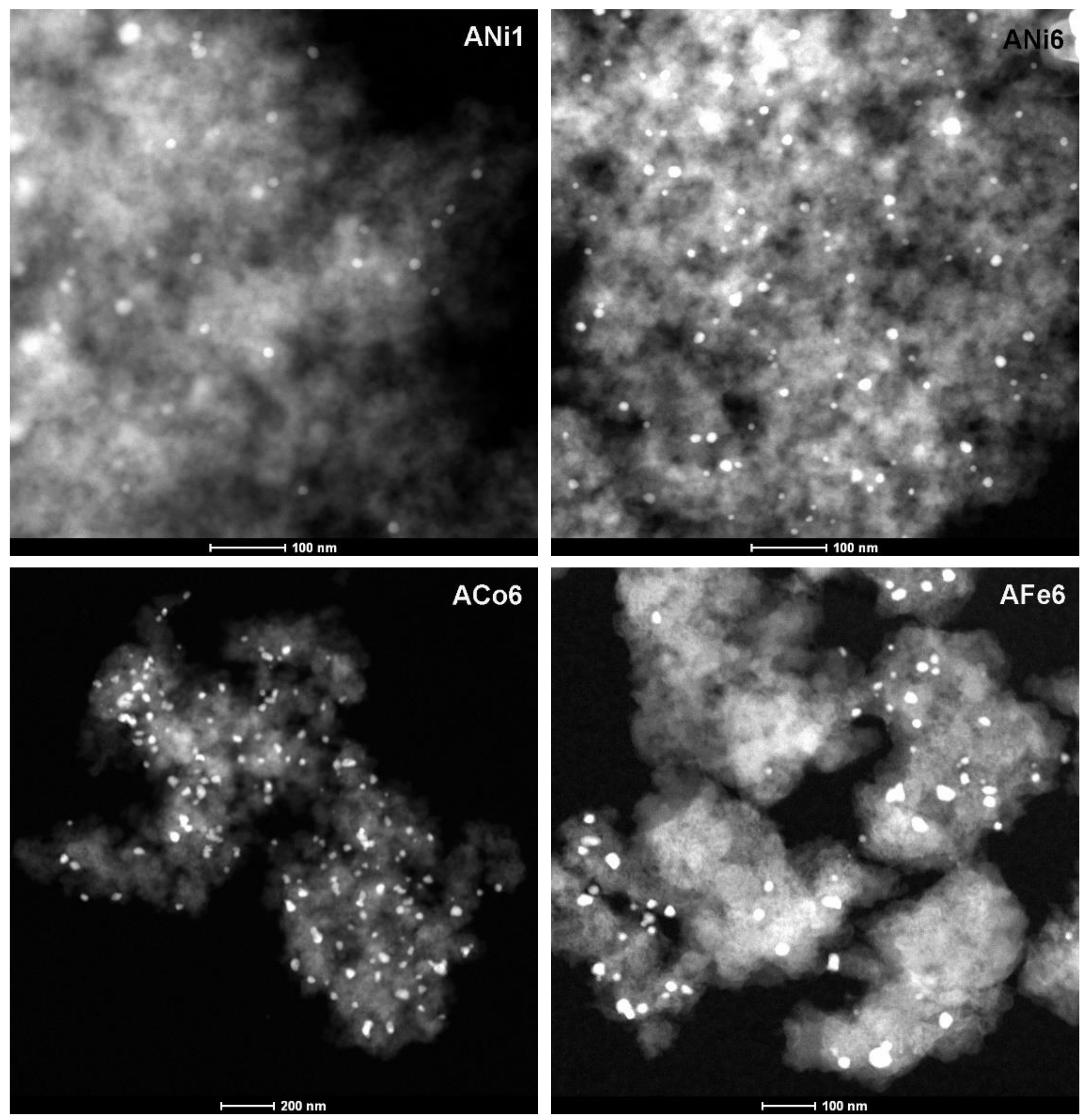

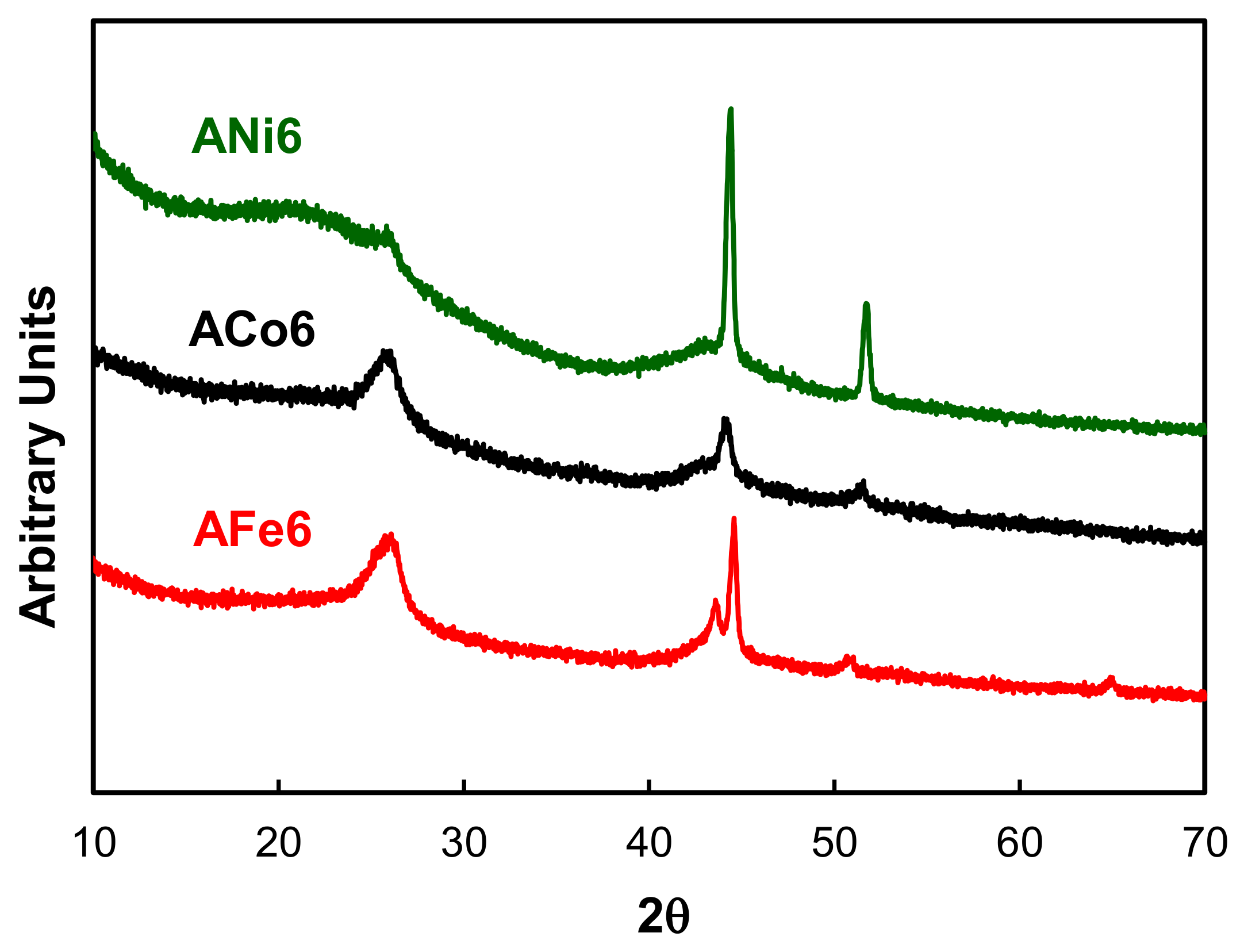
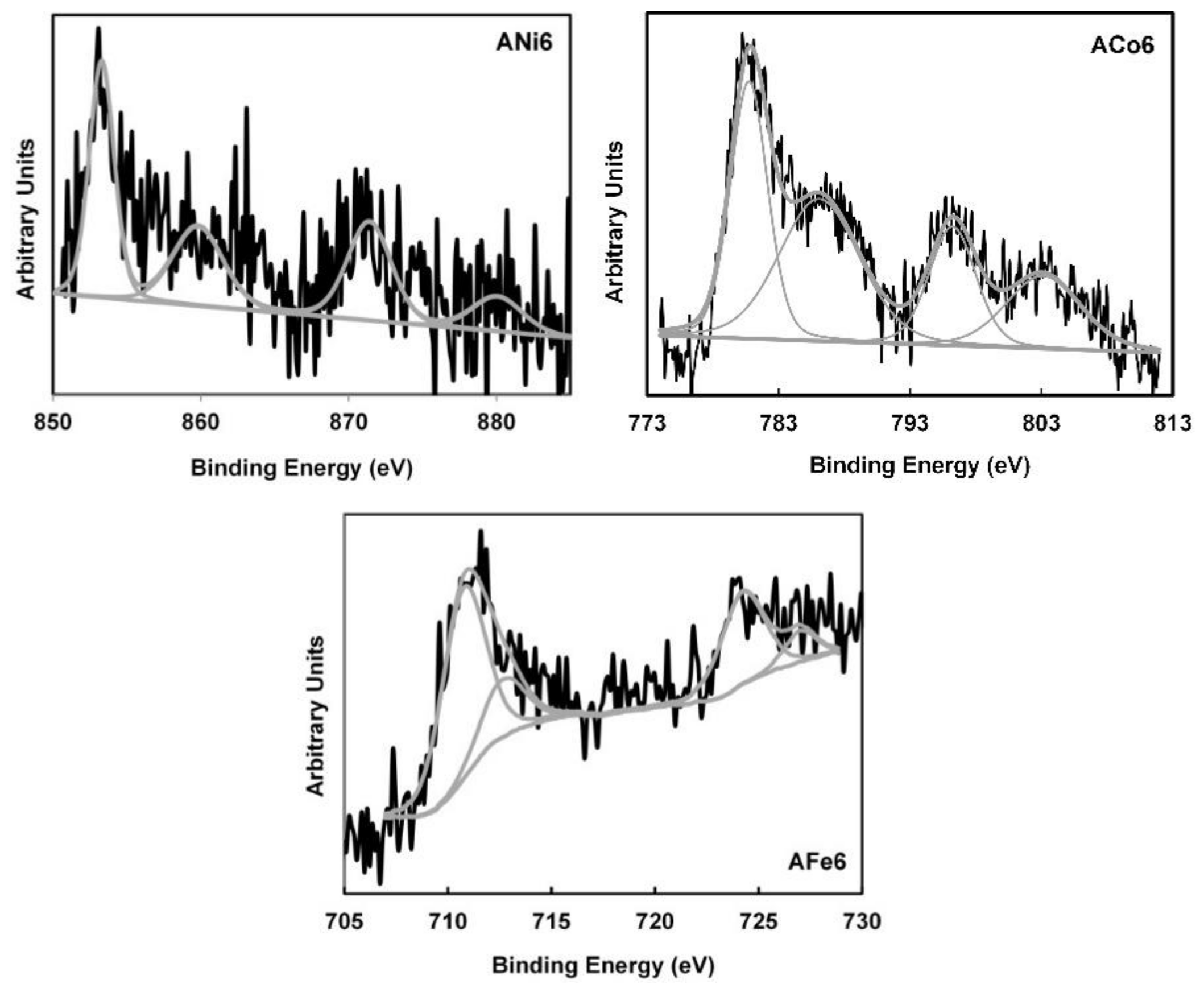



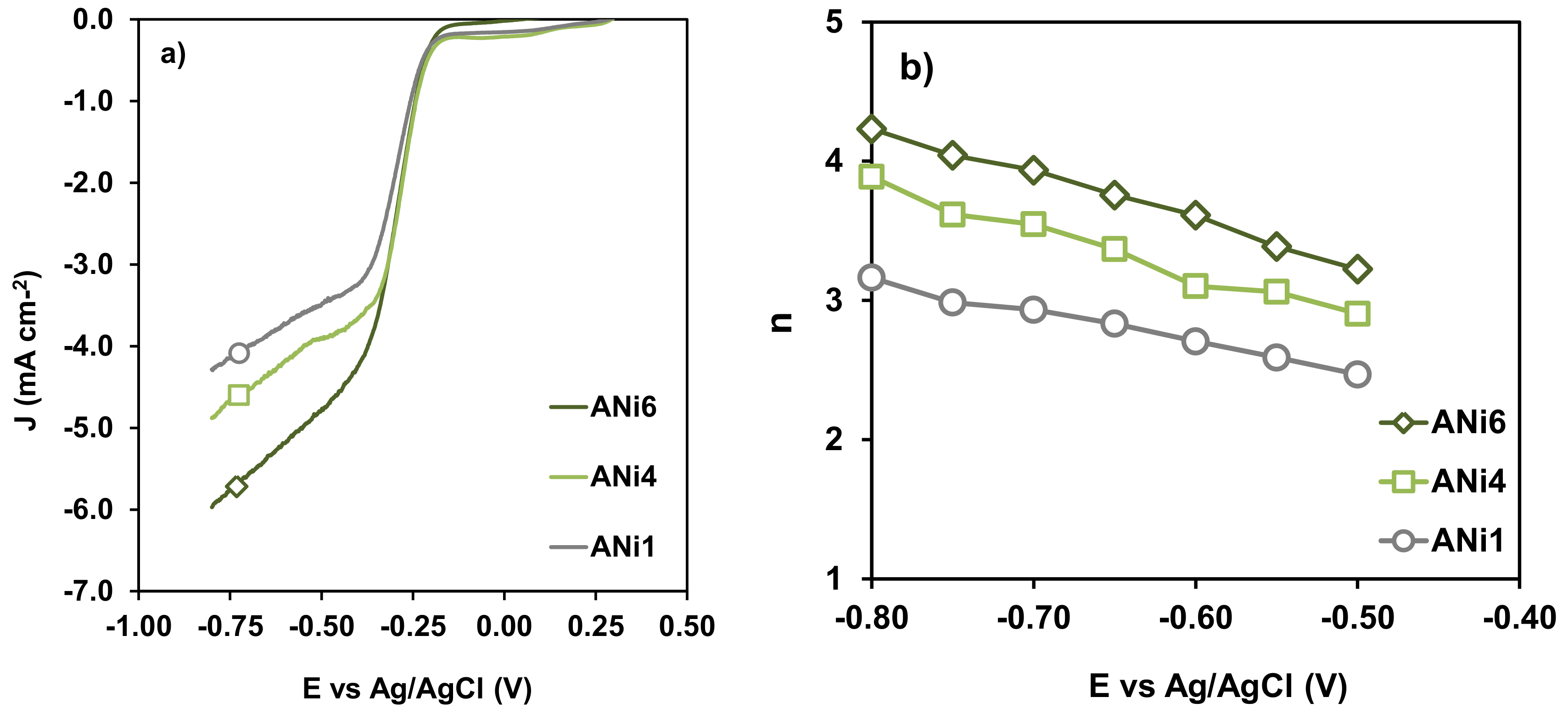

| Sample | SBET | W0 (N2) | L0 (N2) | W0 (CO2) | L0 (CO2) | V0.95 (N2) | VBJH (N2) | LBJH |
|---|---|---|---|---|---|---|---|---|
| m2∙g−1 | cm3∙g−1 | nm | cm3∙g−1 | nm | cm3∙g−1 | cm3∙g−1 | nm | |
| A0 | 700 | 0.276 | 1.20 | 0.249 | 1.06 | 1.21 | 0.89 | 19.8 |
| ANi1 | 663 | 0.258 | 1.07 | 0.276 | 0.63 | 0.82 | 0.54 | 17.1 |
| ANi4 | 685 | 0.268 | 0.96 | 0.280 | 0.63 | 0.71 | 0.46 | 16.9 |
| ANi6 | 698 | 0.273 | 0.90 | 0.294 | 0.64 | 0.69 | 0.48 | 16.8 |
| ACo6 | 589 | 0.230 | 1.00 | 0.181 | 0.57 | 0.65 | 0.40 | 14.1 |
| AFe6 | 461 | 0.177 | 1.00 | 0.182 | 0.62 | 0.41 | 0.25 | 12.3 |
| Sample | MetalTOTAL | MetalXPS | OXPS | dXRD | dHRTEM | IG/ID |
|---|---|---|---|---|---|---|
| wt % | wt % | wt % | nm | nm | ||
| A0 | n.d. | n.d. | 1.4 | n.d. | n.d. | - |
| ANi1 | 1.2 | n.d | 1.6 | 15.9 | 11.9 | 0.97 |
| ANi4 | 3.9 | n.d | 1.6 | 17.4 | 15.5 | 0.99 |
| ANi6 | 5.8 | 0.3 | 1.8 | 21.1 | 17.7 | 0.99 |
| ACo6 | 5.9 | 0.7 | 3.6 | 21.5 | 19.4 | 0.92 |
| AFe6 | 6.1 | 0.4 | 2.9 | 21.6 | 18.6 | 0.89 |
| Sample | Eonset | jk | n |
|---|---|---|---|
| V | mA·cm−2 | ||
| ANi1 | −0.22 | 16.6 | 3.1 |
| ANi4 | −0.21 | 16.9 | 3.9 |
| ANi6 | −0.21 | 28.1 | 4.2 |
| ACo6 | −0.17 | 34.9 | 3.6 |
| AFe6 | −0.22 | 26.2 | 4.1 |
| Catalyst Name | Type of Support | Eonset vs. Ag/AgCl (V) | n | Ref. | Metal wt % | jk mA·cm−2 |
|---|---|---|---|---|---|---|
| ANi6 | Carbon aerogel | −0.210 | 4.2 | This work | 5.8 | 28.1 |
| ACo6 | Carbon aerogel | −0.170 | 3.6 | This work | 5.8 | 34.9 |
| AFe6 | Carbon aerogel | −0.220 | 4.1 | This work | 6.1 | 26.2 |
| 20% Pt Vulcan | Carbon black | −0.037 | 3.9 | [40] | 20 | N.R. |
| 20% Pt/C | Graphitic carbon | −0.050 | 3.9 | [41] | 20 | 5 |
| 20% Pt/C | Graphitic carbon | −0.070 | 4.2 | [42] | 20 | 28.8 |
| 20% Pt/C | Carbon black | −0.065 | 4.0 | [43] | 20 | 14 |
| 20% Pt/C | Carbon black | - | 3.9 | [44] | 20 | ≈29 * |
| Pt/Vulcan | Carbon black | −0.007 | 3.9 | [45] | 20 | N.R. |
| NT_FePc_400 | Carbon nanotube | −0.037 | 3.9 | [45] | 2.1 | N.R. |
| NT_CoPc_400 | Carbon nanotube | −0.150 | 2.4 | [45] | 2.1 | N.R. |
| Co-NCA | Carbon aerogel | −0.150 | 4.0 | [36] | 3 | ≈25 * |
| Fe-NCA | Carbon aerogel | −0.150 | 3.8 | [36] | 5.2 | ≈14 * |
| Fe-NCA5 | Carbon aerogel | −0.051 | 3.8 | [13] | 7.7 | ≈25 * |
| FeCo-N-rGO | Carbon nanotube | 0.050 | 3.9 | [44] | 0.46 | ≈25 * |
| CoNPs/rGO | Graphene oxide | −0.115 | 3.9 | [46] | 0.3 | N.R. |
| Fe3C-CNTFs | Carbon nanotube | 0.105 | 3.1 | [47] | N.R. | 4.89 |
| Co-CNTFs | Carbon nanotube | −0.015 | 3.9 | [47] | N.R. | 5.23 |
| Ni-CNTs | Carbon nanotube | 0.055 | 2.6 | [47] | N.R. | 3.67 |
| Ni | Unsupported | 0 | 0 | [48] | 100 | 0 |
| Co | Unsupported | 0 | 0 | [48] | 100 | 0 |
© 2018 by the authors. Licensee MDPI, Basel, Switzerland. This article is an open access article distributed under the terms and conditions of the Creative Commons Attribution (CC BY) license (http://creativecommons.org/licenses/by/4.0/).
Share and Cite
Abdelwahab, A.; Castelo-Quibén, J.; Vivo-Vilches, J.F.; Pérez-Cadenas, M.; Maldonado-Hódar, F.J.; Carrasco-Marín, F.; Pérez-Cadenas, A.F. Electrodes Based on Carbon Aerogels Partially Graphitized by Doping with Transition Metals for Oxygen Reduction Reaction. Nanomaterials 2018, 8, 266. https://doi.org/10.3390/nano8040266
Abdelwahab A, Castelo-Quibén J, Vivo-Vilches JF, Pérez-Cadenas M, Maldonado-Hódar FJ, Carrasco-Marín F, Pérez-Cadenas AF. Electrodes Based on Carbon Aerogels Partially Graphitized by Doping with Transition Metals for Oxygen Reduction Reaction. Nanomaterials. 2018; 8(4):266. https://doi.org/10.3390/nano8040266
Chicago/Turabian StyleAbdelwahab, Abdalla, Jesica Castelo-Quibén, José F. Vivo-Vilches, María Pérez-Cadenas, Francisco J. Maldonado-Hódar, Francisco Carrasco-Marín, and Agustín F. Pérez-Cadenas. 2018. "Electrodes Based on Carbon Aerogels Partially Graphitized by Doping with Transition Metals for Oxygen Reduction Reaction" Nanomaterials 8, no. 4: 266. https://doi.org/10.3390/nano8040266







